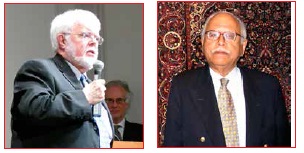Fascinating Lecture on How to Read Islamic Carpets
By C. Naseer Ahmad

Washington, DC: World renowned scholar and author of “How to Read Islamic Carpets” Dr Walter E. Denny presented a fascinating lecture at the Freer Gallery of Art - Meyer Auditorium on January 29, 2015 in Washington. During this lecture, Dr Denny explained how examining the structure, design and placement of carpets in past paintings can be interpreted. The lecture was both entertaining and educational – from historical, cultural as well as trade perspective.
The intellectually invigorating event was hosted by the World Affairs Council DC in collaboration with Freer Gallery of Art, the Smithsonian Institution, the Textile Museum at The George Washington University (GWU) and the Turkish Cultural Foundation. To underscore the commitment to advancing education and higher learning, Dr Steven Knapp, President, the George Washington University also attended the talk along with his wife.
Diplomats, scholars, students, government workers and Washington area business professionals were in the large audience. The conversations during the reception prior to the lecture revealed a continuing interest about Islamic history and societies in Washington.
Introducing Dr Denny’s book, rich with knowledge and historical perspective, the Yale University Press says: “Carpets made in the “Rug Belt”—an area that includes Morocco, North Africa, the Middle East, Central Asia, and northern India—have been a source of fascination and collecting since the 13th century.” During his lecture, Dr Denny shared with the audience some of the beautiful photographs of the carpets from different eras. There are fifty-one new photographs with revealing details in the book.
In his lively and humorous lecture, Dr Denny discussed the design techniques, the materials and the craftsmanship. He then discussed the carpet trade and the socioeconomic context of the works of carpet weavers in different historical periods and geographic regions. His discussion on these carpets covered the cultural and social realm of their production. Dr Denny gave examples of nomadic encampments, rural and urban workshop settings.
One of the amazing photographs he shared with the audience was a carpet made in Lahore – commissioned during the British rule in the Indo-Pak Subcontinent. There are in fact a number of references to Lahore in his book. He also shared pictures of Islamic carpets in European churches. Dr Denny informed the audience about the carpets as a symbol of wealth and that the presence of such carpets in the background of royal portraits in Europe and elsewhere.
Both Dr Denny’s discussion as well as the displays told the story of Islamic carpets evolving into precious objects in the art galleries around the world. He showed pictures of some of the most exquisite carpets on display in art galleries in US, Europe, and most recently, in Qatar. He showed the picture of a magnificent carpet on display in the Lyndon B. Johnson Library, Austin, Texas.
According to the Yale University Press, Dr. Denny's book "is an essential guide for students, collectors, and professionals who want to understand the art of the Islamic carpet.” But, for those in the audience, it was history coming alive through the words and pictures presented by Dr Denny.
By hosting Dr Denny, together with the Smithsonian Institution and GWU, the World Affairs Council DC once again proved that Washington is “where learning happens.”
And, carpets as gifts are not just relegated to the books. For a number of years, the National Press Club in Washington proudly displayed a carpet gifted from Prime Minister Nawaz Sharif – in his earlier tenures.

